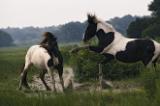 © Bruce McNitt/Panoramic Images (Virginia)
© Bruce McNitt/Panoramic Images (Virginia)

Virginia Wildlife Action Plan
By the Association of Fish and Wildlife Agencies
Virginia’s Wildlife Action Plan united its natural resource agencies and citizens through a common vision and concept for the conservation of the Commonwealth’s wildlife and the habitats in which they live. It also provides a means for prioritizing actions and spending for the greatest return. The Action Plan includes 925 species of greatest conservation need, representing a broad array of wildlife, and it focuses on the habitats that support them, such as caves, high elevation forests, coastal marshes, and barrier islands.
Most importantly, the Action Plan identifies the tasks needed to conserve these species and habitats on a regional basis. While many of these actions are direct on-the-ground activities, priorities for enhancing partnerships and increasing public awareness are also included. The work of conserving wildlife can be challenging, but it is possible, and this Action Plan provides the needed direction.
Management
Nearly 10% of Virginia is public land—one of the largest percentages of public holdings of any state along the Eastern Seaboard. These lands are managed by an array of federal, state, and local government agencies, often in cooperation with local non-profit organizations. Programs that provide technical and financial assistance for habitat conservation and restoration on private lands are vital to sustaining Virginia’s rich and diverse wildlife resources.
Wildlife Highlights
Peregrine falcons soar from the beaches to the mountains, making their homes occasionally in Virginia’s cities. The incredibly rich diversity of native mussels, with interesting names like elephant-ear, rabbitsfoot, and Tennessee heelsplitter, inhabit nearly 40,000 miles of rivers and streams.
Primary challenges to conserving wildlife in Virginia
Habitat destruction and fragmentation dominate the list of problems facing terrestrial wildlife in the Commonwealth. For Virginia’s aquatic wildlife, the Action Plan identifies certain agricultural and forestry practices that have greatly affected water and habitat quality. Pollution and habitat changes from industry and municipal development are also critical issues for aquatic species.
Many grassland wildlife species are experiencing dramatic declines in populations because of the loss of grassland and savannah habitats across the Commonwealth. These important habitats are being converted to other agricultural crops (including cool season grasses), are being lost as farms are converted for municipal uses, and are being replaced by other habitats when farmlands are abandoned and allowed to mature into forested lands.
Habitat degradation in the rivers of southwestern Virginia, resulting from certain mineral extraction and agricultural practices, and as well as from the impoundment of these rivers downstream in Tennessee, has significantly impacted this biologically diverse “hot spot” in the United States. Over one-half of the freshwater mussel species found in this watershed are now listed as threatened or endangered. These species, which are important food sources for other wildlife and which serve as filterers in these rivers, are highly dependent on good water quality.
Working together for Virginia’s wildlife
The Virginia Wildlife Action Plan was developed with input from a wide array of public and private agencies and organizations. A steering committee composed of representatives of state and federal agencies, private conservation organizations, and land management entities provided guidance throughout the development of the plan. Technical committees comprised of more than 50 scientific experts from around Virginia provided input into the development of the list of species of greatest conservation need, the identification of the habitats that support them, the problems these resources face, and important conservation actions needed to address these threats. Key partners from public and private interests will become part of the steering committee that is guiding the implementation of the plan; all agencies, groups and organizations interested in wildlife conservation can participate in the implementation working groups.
An important component of the development of the Virginia Wildlife Action Plan was the participation of citizens from around the state. Efforts to involve Virginians included numerous presentations to groups throughout Virginia, news releases, periodic mailings, fact sheets, radio and newspaper interviews, and a dedicated project Web site. In fact, the Wildlife Action Plan project Web site was used as the primary tool for soliciting comments from the public.
Twenty-two meetings were held across the Commonwealth, attended by nearly 200 individuals representing over 100 agencies and organizations and themselves. At these meetings, participants were asked to identify what, in their opinions, was working well in Virginia in wildlife conservation and what needed improvement in this area. They were also asked to identify and rank the top issues facing wildlife and habitats in their communities now and in the next decade, along with local solutions to address those problems.
The Virginia State Wildlife Action Plan is available in full online, here.
The Association of Fish and Wildlife Agencies represents all of North America’s fish and wildlife agencies, promotes sound management and conservation, and speaks with a unified voice on important fish and wildlife issues.






